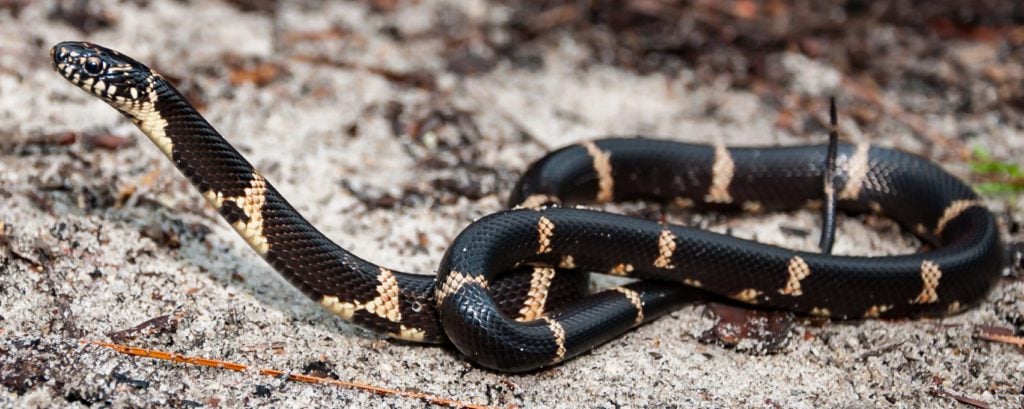3 Types of Kingsnakes & Milksnakes in Maryland!
Finding kingsnakes and milksnakes in Maryland can be difficult!

Here’s why:
Most members of the genus Lampropeltis (kingsnakes & milksnakes) spend a lot of their time hidden beneath objects or underground. So while it’s not unheard of, it’s not very common to just stroll past one while walking outside.
Regardless, these non-venomous, mostly docile snakes are fascinating. For example, did you know that kingsnakes EAT venomous snakes? Believe it or not, it’s true!
Today, you’re going to learn about the 3 types of kingsnakes and milksnakes in Maryland!
-
RELATED: The 21 Types of SNAKES That Live in Maryland! (ID Guide)
-
RELATED: The 6 Types of Lizards Found in Maryland! (With Photos)
#1. Eastern Milksnake
- Lampropeltis triangulum triangulum

Identifying Characteristics:
- Adults typically range from 24 to 36 inches in length.
- Coloration is tan or gray with 3 to 5 rows of reddish-brown, black-edged blotches.
- Look for a gray or tan Y- or V-shaped mark near the rear of the head.
Eastern Milksnakes get their unique name from an old myth that they milked cows since they’re commonly found in barns! Obviously, this isn’t true. Their presence inside barns is likely due to the high number of mice, which are some of their favorite prey.
Eastern Milksnake Range Map

A member of the kingsnake family, Eastern Milksnakes occupy a wide variety of habitats in Maryland, including fields, woodlands, agricultural areas, and rocky outcrops. These beautiful snakes are somewhat secretive and spend much of their time beneath the ground. You may be able to find one underneath rocks, logs, boards, and other debris.
The Eastern Milksnake prefers to feed on small mammals such as mice and shrews. However, they’ll also consume various types of prey, including birds and bird eggs, lizards, snakes, amphibians, fish, earthworms, slugs, insects, and carrion.

Like other individuals in the kingsnake family, they will prey on venomous pit vipers. So how do they combat the venom? Interestingly, their blood contains venom-neutralizing properties!
#2. Northern Mole Kingsnake
- Lampropeltis calligaster rhombomaculata
Identifying Characteristics:
- Adults range from 30 to 40 inches in length.
- Coloration is gray, light brown, or orangish with black-bordered darker brown, gray, or reddish-brown blotches down its body, which fade with age.
- The head is indistinct from the body, and there is sometimes a dark line through the eye.
- Also called the Brown Kingsnake.
A subspecies of the Yellow-bellied Kingsnake, the Northern Mole Kingsnake prefers open habitats in Maryland near forest edges. These snakes are difficult to find since they spend most of their time underground in old animal burrows or under logs and rocks. You’re most likely to spot one crossing the road at night.
Northern Mole Kingsnake Range Map

A nocturnal species, the Northern Mole Kingsnake feeds primarily on rodents. However, they’ll also prey on lizards, frogs, and occasionally other small snakes. These snakes are constrictors, and they asphyxiate their prey by coiling around it and squeezing it before consuming it.
The secretive nature of these kingsnakes means that they rarely come into contact with people. They’re non-venomous but may shake their tail as a warning which can sound a bit like a rattlesnake when done in dry leaves. They’re generally quite docile but may bite if grabbed.
#3. Eastern Kingsnake
- Lampropeltis getula

Identifying Characteristics:
- Adults typically range from 36 to 48 inches in length.
- Coloration is shiny black with white or yellow chain-link bands, but some individuals may be entirely black.
- Stout head and small beady eyes.
- Also called the Common Kingsnake.
Eastern Kingsnakes thrive in various habitats in Maryland!
Look for them in hardwood and pine forests, bottomlands, swamps, and wetlands, as well as farmlands and suburban areas. They are a terrestrial species but are often associated with water preferring riparian habitats along stream banks or marsh edges.
Eastern Kingsnake Range Map

A very secretive species, the Eastern Kingsnake is frequently spotted when moving logs, boards, tin, or other objects they use for cover. They’re constrictors and feed on various types of prey, including rodents, lizards, birds, and turtle eggs. Incredibly, they’re immune to venom from pit-vipers and regularly feed on smaller venomous snakes like copperheads, cottonmouths, and rattlesnakes!
If disturbed, these snakes can mimic rattlesnakes by shaking their tails in dry leaves. They may also release a foul-smelling musk and bite if captured.

Unfortunately, the Eastern Kingsnake has seen dramatic declines in many areas. This is most likely due to habitat loss and degradation, imported fire ants, and disease.
Do you need additional help identifying a snake?
Try this field guide!
Which of these kingsnakes and milksnakes have you seen before in Maryland?
Leave a comment below!


